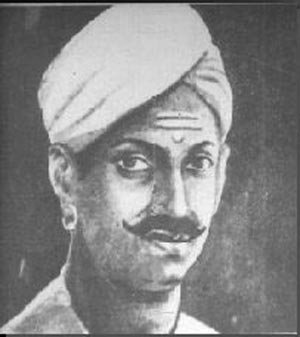
Mangal Pande July 19, 1827-8 April 1857), also known as Shaheed Mangal Pandey, was a sepoy (soldier) in the 34th Regiment of the Bengal Native Infantry (BNI) of the British East India Company.
Pande was born in the village of Nagwa in district Ballia, Uttar Pradesh. He joined the British East India Company forces in 1849 at the age of 22, as per this account. Pandey was part of 5th Company of the 34th BNI regiment. He is primarily known for attacking his British officers in an incident that sparked what is known to the British as the Sepoy Mutiny of 1857 and to Indians as the First War of Indian Independence.
Mangal Pande is considered to be the First Warrior in India’s long struggle for independence from the British rule.
At Barrackpore near Calcutta on March 29, 1857, Pande attacked and injured his British sergeant on the parade ground, and wounded an adjutant with a sword after shooting at him, but instead hitting the adjutant’s horse. He was however attacked by a native soldier called Shaikh Paltu who prevented him from killing the adjutant and later the sergant-major.
When General Joyce Hearsay ordered the Jemadar of the troops, a man called Ishari Pande, to arrest him, the Jemadar refused, as did the rest of the company except Shaikh Paltu. Mangal then turned the gun against himself, and used his foot to try to pull the trigger to shoot himself.
He failed, was captured and sentenced to death along with the Jemadar. Mangal Pandey was hanged on April 8. His execution was scheduled for April 18, but he was summarily executed 10 days prior to the date, fearing the possibility of a larger-scale revolt. The Jemadar Ishari Pandey was executed on April 22. The whole regiment was dismissed on 6th May as a collective punishment, because it was felt that they harboured ill-feelings against their superiors. Shaikh Paltu was promoted on the spot.
The primary motivation behind Mangal’s behaviour is attributed to a new type of bullet cartridge used in the Enfield P-53 rifle introduced in the Bengal Army that year.
The cartridge was rumoured to be greased with animal fat (primarily pig and cow fat, which are not consumed by either Hindus or Muslims, the primary religions in the Bengal Army) 1. The cartidges had to be bitten to remove the cover, and that was abhorrent to the soldiers. 2. The general feeling was that this was intentional on the part of the British, to defile their religions.
The P-53 was officially known as the Pattern 1853 Enfield Rifle Musket. Introduced in the British Army by the War Department during 1854 in the Crimean War, they proved very effective at a range of 50 to 300 yards. It was introduced in the Bengal Army by the East India Company in early-1857.
To load his rifle, the sepoy had to first bite off the rear of the cartridge to pour the powder down the barrel. he then inverted the tube (the projectile was placed in the cartridge base up), pushed the end-portion into the muzzle to the approximate depth of the bullet and tore off the remaining paper. The bullet could then be easily rammed on top of the charge.
Since Hindus consider cows as holy and Muslims regard pigs as dirty, native sepoys could be expected to have reservations in its usage. The company therefore kept this fact a secret. Thus, when it came out as a rumour, it had an even more damaging effect, as all kinds of rumours started spreading. For instance, it was thought that the British planned to make their sepoys outcaste in the society in order to force them to convert to Christianity. Another rumor said the British had manipulated the wheat flour distributed to the sepoy with bones of cows. The matters could have been worsened by the fact that an overwhleming number of sepoy in the Bengal Native Infantry was made of Brahmin sepoys from Awadh. As Brahmins are generally vegetarians and are not supposed to eat or touch meat, the resistance was even stronger.
Failing to incite the spirit of nationalism in his comrades Mangal tried to end his life. He turned the gun against himself and used his foot to try to pull the trigger to shoot himself. But Mangal failed and was captured. He was court-martialed on April 6 and was hanged at Barrackpore on April 8, 1857.
His execution was actually scheduled for April 18. But was carried out ten days earlier Because the Britishers feared the possibility of a massive revolt. As a collective punishment for his act, the entire regiment was also dismissed. This was the end of the first warrior of Indian Independence.

